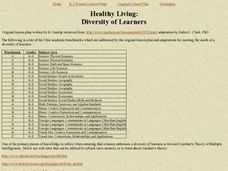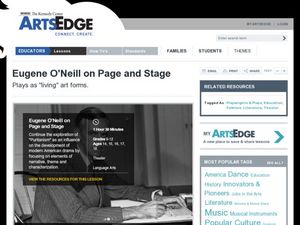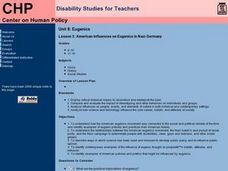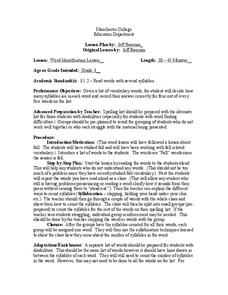Curated OER
Walking the Line
Students participate in activities that engage all learning styles (such as picture walks, tracing lines, movement/theatre technique) as an introduction to the art element of line and its importance to art.
Curated OER
Justice Demands an End to Segregation, But it Does Not End
Students define human rights and describe how it applies to politics, economics and cultural rights. As a class, they watch a video how the Constitution was made and discuss its purpose. In groups, they present information to the class...
Curated OER
Healthy Living: Diversity of Learners
Learners are drawn to those activities that are in line with their individual intelligences. They use classroom computers to find fruits and their names in other languages. Once a fruit is identified, students practice saying the name of...
Curated OER
Eugene O'Neill on Page and Stage
Students investigate the life and works of Eugene O'Neill. In this American theater lesson, students read biographical information about O'Neill and review Long Day's Journey into Night. Students then analyze the play in order to deliver...
Curated OER
Fractured Families in American Drama
Young scholars compare and contrast the flawed families in two plays. In this American drama lesson, students read Cat on a Hot Tin Roof and Long Day's Journey into Night. Young scholars research information about the playrights and...
Curated OER
Rhythm & Improv: Jazz & Poetry
Students analyze the elements of poetry and jazz. In this critical thinking skills lesson, students take a closer look at the rhyme, rhythm, alliteration, form, free verse, lyricism, and imagery that exist is jazz as well as poetry.
Curated OER
Rhythm and Art: Elements of Art
Students discover the three elements of art. In this visual arts lesson, students examine line, shape, and color of works by Torres-Garcia and Picasso. Students then identify the elements of art in works by other artists.
Curated OER
Rhythm and Art: Gesture Drawing
Students make connection between music and art. In this integrated arts lesson plan, students complete gesture drawing activities as they listen to Cuban, flamenco, classical, jazz, and contemporary music.
Curated OER
How the Brain Learns
Students identify the basic function of the lobes in the brain. In this memory lesson students complete a lab activity on how fast they can react.
Curated OER
How the West Was One - Three x Four
While this lesson provides a motivating and interesting way to review the concept of the order of operations, it involves the use of software called How the West Was One + Three x Four. There are also other resources that are referenced,...
Curated OER
Able Sports
Students work together to design a new sport for disabled persons. They share their new sport with the class. They discover how mechanical and biomedical engineers use information to test prosthetics.
Curated OER
Exposes in Different Eras: The Work of Dorothea Dix and Burton Blatt
Young scholars discover that Dorothea Dix was the first to make the pubic aware of the terrible living conditions of people with mental illness in the 1800's. They evaluate the influence of citizen action on public policy.
Curated OER
American Influences on Eugenics in Nazi Germany
Students examine the Eugenics movement in America. They discover the Nazi's belief in racial purity and how it relates to Eugenics. They also analyze how science has been influential in creating public policy.
Curated OER
Help, I can't reach it!
Young scholars learn the major organ systems in the human body and research simple machines on the Internet; They design an informational brochure about a medical profession and present that career topic to the class.
Curated OER
123/ABC Hopscotch
Pupils practice alphabet recognition, alphabet sounds, and number readiness while playing a hopscotch type game.
Curated OER
Word Identification Lesson
Third graders listen to a list of Fall words and then repeat them aloud as a class. They discover how to count syllables either by holding their hand under their chin or clapping and practice together as a class and then split into small...
Curated OER
American Deaf Culture: A History of Language
Students examine the relationship between language and culture in the Deaf Community. They discover the history of sign language and how it has been viewed in the past. They examine the Deaf community's beliefs and values.
Curated OER
American Deaf Culture: Deaf Art
Students examine the culture and art of the Deaf Community. They discover the history of the Deaf Community using art and their values. They compare and contrast different pieces of art.
Curated OER
Volcanoes In Japan
Sixth graders study the characteristics of volcanoes in this unit. They apply the research to the study of three volcanoes in Japan. They complete mapwork, identify indicators of impending volcanic activity, and describe the dangers...
Curated OER
Autism Spectrum Disorders: The New Rainbow
Learners conduct research into the area of Autism Spectrum Disorders. They use the internet and a variety of resources in order to obtain information. Students use the information to take part in a writing project of authoring a new...
Curated OER
Standard Linear Form
Ninth graders identify and describe the x-intercept as the place where the line crosses the x-axis as it applies to football. They create their own differentiations to reinforce the distinction between the x-intercept and the...
Curated OER
Financial Planning
Students participate in activities in order to apply the skills of sound financial planning that includes creating and maintaining a budget. The lesson is intended for diverse learners because of the application of The Multiple...
Curated OER
Plotting Earthquakes: Diversity of Learner Adaptation
Students are divided into four groups that study four separate ecosystems in the community. They first do a field examination for the purpose of developing a detailed report of an ecosystem. Students do a detailed analysis of the...
Curated OER
Abridged and Unabridged Dictionaries
Students perform research into the history and formation of the English Language. The use of multiple types of activities is used for application of the theory of Multiple Intelligences.

























